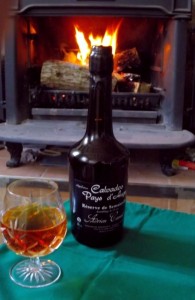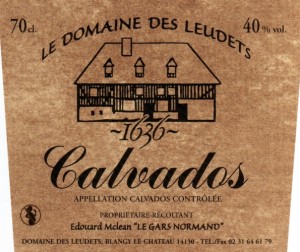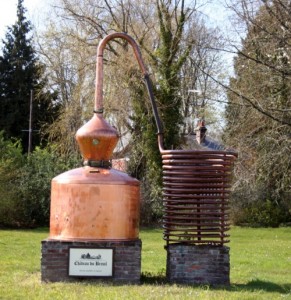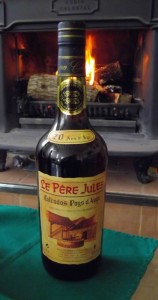 Last week the travelling distiller, known as the Ambulante, came by to distill our last year’s flat cider. We are surrounded by cider and Calvados makers. Pere Magloire and the Chateau du Breuil are huge industrial enterprises on the roads from Pont l’Eveque to Deauville and Lisieux. Le Pere Jules, Christian Drouin, Camut and Boulard are more family businesses. There are plenty more small distillers like us hidden along the back doubles.
Last week the travelling distiller, known as the Ambulante, came by to distill our last year’s flat cider. We are surrounded by cider and Calvados makers. Pere Magloire and the Chateau du Breuil are huge industrial enterprises on the roads from Pont l’Eveque to Deauville and Lisieux. Le Pere Jules, Christian Drouin, Camut and Boulard are more family businesses. There are plenty more small distillers like us hidden along the back doubles.
In France, distillation could only be done by inherited right until recently and many a still was ripped out by the excise people. One of the tax men in Pont l’Eveque told me that was part of his job years ago. He laughed regretfully when I told him he should be ashamed to have helped destroy Normandy’s heritage.
Nowadays, the excise taxes need only be paid on Calvados when the spirit is bottled — and anyone who produces cider can distill.
Once the apples are pressed and the cider has completed its fermentation and has no sugar left, it can be distilled. The distinctive Normand pot still, the alambic (al Lambic) was brought back by the Crusaders from Salerno where the mix of Arab and local culture threw up some new ideas — the distillation of alcohol was a good one.
It was at first called Eau de Vie (water of life) because it seemed to be a cure-all. It was still a favourite gargling liquid, disinfectant and chest rub on French farms during the 60’s and 70’s. At christenings, a baby was given a drop to make sure he was a real Norman, and many a school child had a little in his morning coffee to keep him warm on the walk to school.
 Calvados is always distilled twice because le brouillis, as the first distillation is called, has too harsh a taste. Distillation was really started because wine travelled badly (probably that “new wine old casks problem”). In fact, sour wine was the origin of vinegar ( known as bitter wine from Orleans – vin aigre d’Orleans). Double distillation is the only kind permitted for Appellation Controlee Calvados Pays d’Auge. And it has to be in a copper alembic because there is a chemical reaction which takes place between other metals, heat and alcohol, which gives very unpleasant tastes.
Calvados is always distilled twice because le brouillis, as the first distillation is called, has too harsh a taste. Distillation was really started because wine travelled badly (probably that “new wine old casks problem”). In fact, sour wine was the origin of vinegar ( known as bitter wine from Orleans – vin aigre d’Orleans). Double distillation is the only kind permitted for Appellation Controlee Calvados Pays d’Auge. And it has to be in a copper alembic because there is a chemical reaction which takes place between other metals, heat and alcohol, which gives very unpleasant tastes.
The volume and shape of the alembic are very important to the production of a fine apple brandy. The neck must be so long, the coil so long and the alcohol must come out at such and such a temperature to prevent nasty deposits forming along the coils. The way the alembic (pot still) is placed on its brick support to assure the maximum heat spread and avoid hot-spots is also prescribed.
The second distillation i s the most important for it is at this stage that the first milky liquid is drawn off from the brouillis and rejected. This is the head. Next to be drawn off is the heart of the water of life, le coeur de pomme. This liquid is crystalline and limpid. Now the distiller has to be very careful to separate the clear liquid from the lees or tails so that he has a translucent pleasant tasting liquor.
s the most important for it is at this stage that the first milky liquid is drawn off from the brouillis and rejected. This is the head. Next to be drawn off is the heart of the water of life, le coeur de pomme. This liquid is crystalline and limpid. Now the distiller has to be very careful to separate the clear liquid from the lees or tails so that he has a translucent pleasant tasting liquor.
When alcohol was first distilled the resulting liquor was so bitter that it was usual to add herbs and sugar to mask the acidity. Hence the growth of liqueurs! Since 1800, when column stills were invented, most producers outside the Pays d’Auge use this, as the two distillations can be done simultaneously. The distillation in a pot still, however, must be done in two phases, the first producing alcohol at 29% and the second at 70%. Like whiskey, Calvados must be watered down to reach 45%.
It is then kept in oak barrels for at least three years from which it draws the tannins and its rich golden colour. However, this rich colour will not be obtained unless the Calvados has at least eight years in the barrel. The colour is helped along by the addition of caramel. A three star Calva has only been in its barrel for three years. The one called Vieux or Reserve has only four years in the barrel. VSOP is five years in the barrel, and Extra, Napoleon, Hors d’Age need to be aged for a minimum of seven years.
 A really smooth Calvados is quite hard to come by, but Christian Drouin of Le Coeur de Lion does his utmost and some of his Calvados is more than 25 years old. He inherited the business from a great uncle some time in the 1960’s and fought alongside other Calvados producers to have the drink given an AOC from 1966 to 1984, and to raise the standards of production. Lots of people had come to him with barrels of Grandad’s Calva for sale and he said it was little more than hooch or moonshine or, as Zola called it, “that terrible Norman eau de vie”.
A really smooth Calvados is quite hard to come by, but Christian Drouin of Le Coeur de Lion does his utmost and some of his Calvados is more than 25 years old. He inherited the business from a great uncle some time in the 1960’s and fought alongside other Calvados producers to have the drink given an AOC from 1966 to 1984, and to raise the standards of production. Lots of people had come to him with barrels of Grandad’s Calva for sale and he said it was little more than hooch or moonshine or, as Zola called it, “that terrible Norman eau de vie”.
Emmanuel Camut works with three generations of know-how and produces the softest Calvados I have ever tasted; however, the died-in-the-wool oldies didn’t like it much, referring to it as a woman’s drink.
Hugues Desfrieches, of Le Pere Jules produces fabulous Calvados too and has been really helpful and generous with his advice to us. He occasionally invites us over to help him pass the long dark hours of the night when he is on Calvados watch. As they have such a big businesses, they work around the clock distilling. There is a huge copper alembic above a brick-surround which houses the oven.
Hugues feeds with logs all night long to keep the distillation going. He’ll invite us over for a dinner sur le pouce (a quick snack) – usually some pate we just spread on bread, with salad, a good cheese and an apple tart made by his wife who is at home looking after the kids. We sit there in the warm glow of the furnace and sip their apple brandy while Hugues tells us Calvados-maker’s secrets. We stagger home by the dawn’s early light.
Last year we started to sell our own Calvados which has nine years in the barrel. As our orchard is AOC (appellation controlee) approved we will be able to use that distinctive mark on our label. We already hit upon a cunning plan for selling the utterly clear apple spirit. We hadn’t put it in the requisite Oak barrels to take colour because we had too much. Some was put down in barrels bought from one of Hugues’ brothers in Honfleur – the tonnelier or barrel-maker, and the rest we kept in the big plastic food containers. This we called Crystal de Blangy and we sell it, like vodka, to be mixed.
Most of our French friends are great gourmets and nearly all of them had a granddad in the depths of the countryside who made Calvados, so they appreciate ours and recommend it to friends. This is called bouche a l’oreille (word of mouth) and is the absolute best recommendation. We don’t have to advertise and in any case, Ted’s new 2CV has his name and logo plastered all over it and he always delivers in the van, very often dressed in his kilt. You could hardly miss him, if you tried! Our Calvados has nearly sold out already. Everybody says it is so smooth or, as the Normans say, like the Lord himself in velvet trews! Obviously, a heavenly experience!
Photos © J McLean
1. Camut’s Calvados
2. Calvados Label
3. The pot still or alembic at the Chateau du Breuil
4. Le Pere Jules’ Calvados
5. Two column still



[…] This post was mentioned on Twitter by Dan L Hays. Dan L Hays said: RT @lifeasahuman: New Article, The Season for Calvados – French Apple Brandy – http://tinyurl.com/26fnwh8 […]